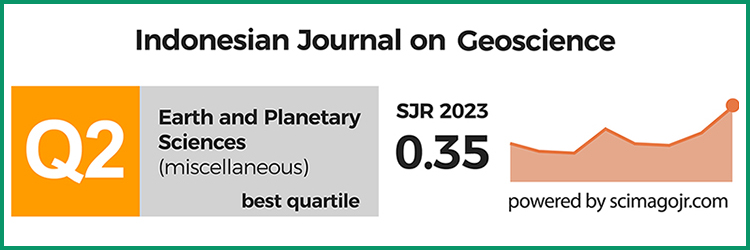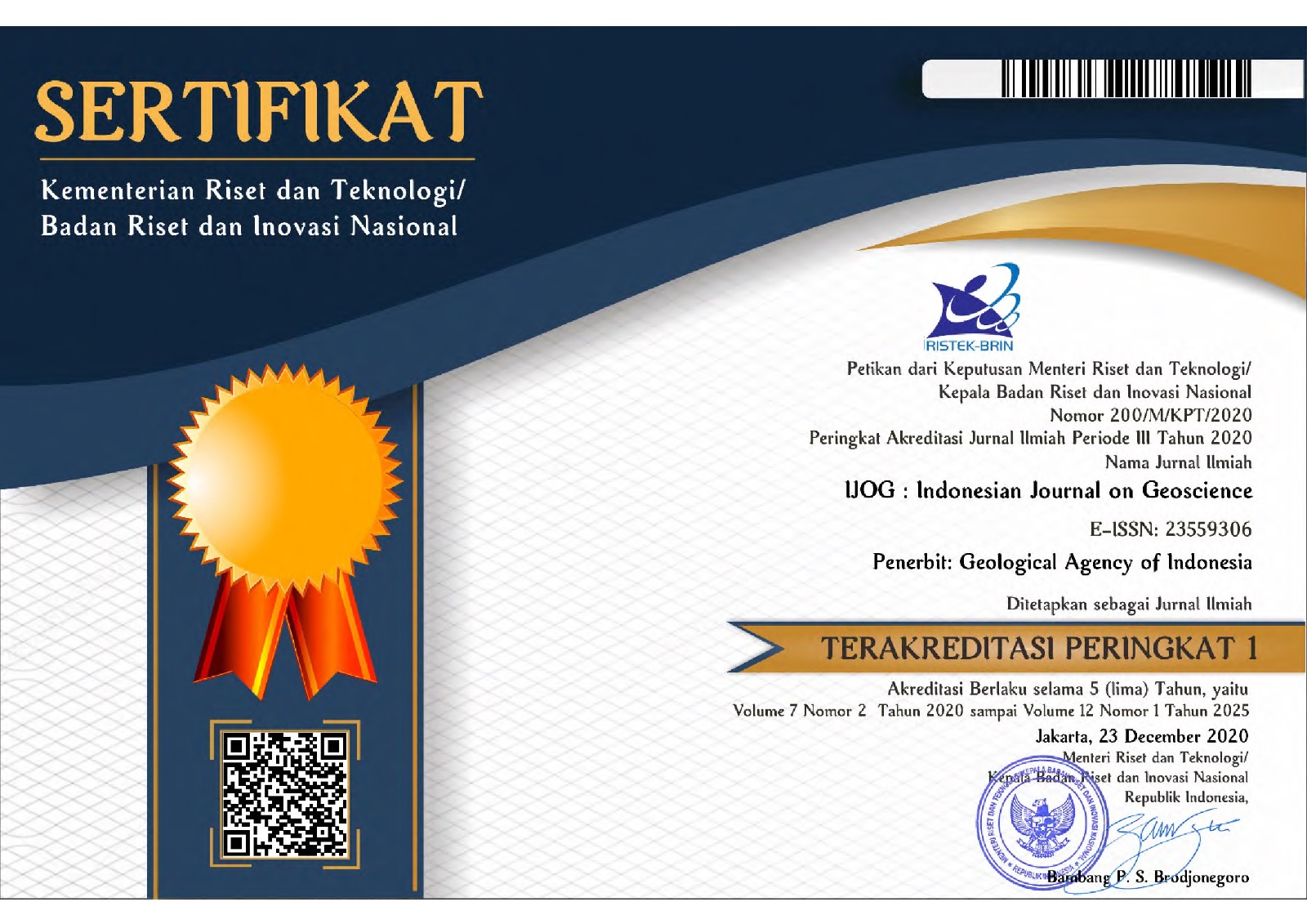Nutrient Level Change Based on Calcareous Nannofossil Assemblages During Late Miocene in Banyumas Subbasin
DOI:
https://doi.org/10.17014/ijog.3.3.183-194Keywords:
nutrient level, nannofossil, Late Miocene, classical turbiditeAbstract
DOI:10.17014/ijog.3.3.183-194
Hydrographic situation on surface waters is more challenging to be understood, related to global and regional climate change in tropical regions. In addition, records from these tropical areas are limited compared to other areas of subtropical and polar regions. The aim of this study is to reconstruct Cenozoic paleoceanography, in particular nutrient level, using outcrop samples from Kali Pasir, Banyumas, Indonesia. This study is focused on the relationships of the relative abundance of Discoaster, coccolith size of Reticulofenestra, and lithofacies characteristics. Nutrient level is reconstructed using quantitative analysis of calcareous nannofossil by counting calcareous nannofossils on 400 fields of View (FOV) for each sample. The abundance of Discoaster and the large Reticulofenestra represent a deep thermocline and nutricline, which is a typical of oligotrophic condition. This condition also associated with the muddy facies in the early stages of Late Miocene (NN8-NN10a). Conversely, decreasing Discoaster abundance and the abundance of small Reticulofenestra indicate a shallow thermocline and nutricline, resulting strong eutrophication of surface waters in the later stage of Late Miocene (NN10b-NN11). A high nutrient content in this stage is related to classical turbidite deposits. A change in a sea surface resulted in strong eutrophication, which is in this section similar to the eastern Indian Ocean micropaleontology records during the Late Miocene (NN10). This finding shows that strong eutrophication in Kali Pasir section is probably driven by nutrient-rich terrestrial material related to the onset of Indian monsoon during the Late Miocene.
References
Ballegeer, A.-M., Flores, J.A., Sierro, F.J., and Andersen, N., 2012. Monitoring fluctuations of the Subtropical Front in the Tasman Sea between 3.45 and 2.45 Ma (ODP site 1172). Palaeogeography, Palaeoclimatology, Palaeoecology, 313-314 (1), p.215-224.
Baumann, K-H., Böckel, B., and Frenz, M. 2004. Coccolith contribution to South Atlantic carbonate sedimentation. In: Thierstein, H.R. and Young J. R. (Eds.), Coccolithopores: From Molecular Processes to Global Impact, p.377. Springer, doi:10.1007/798-3-662-06278-4
Beltran, C., Rousselle, G., Backman, J., Wade, B.S., and Sicre, M.A., 2014. Paleoenvironmental conditions for the development of calcareous nannofossil acme during the late Miocene in the Eastern Equatorial Pacific. Paleoceanography, 29, p.210-222.
Bolliet, T., Holbourn, A., Wolfgang, K., Carlo, L., Catherine, K., Beaufort, L., Markus, K., Andersen, N., and Carl-Dieter, G. S., 2011. Mindanao Dome variability over the last 160 kyr: Episodic glacial cooling of the West Pacific Warm Pool. Paleoceanography, 26, p.1-18. https://doi.org/10.1029/2010PA001966
Chiyonobu, S., Sato, T., Narikiyo, R., and Yamasaki, M., 2006. Floral changes in calcareous nannofossils and their paleoceanographic significance in the equatorial Pacific Ocean during the last 500000 years. Island Arc, 15, p.476-482.
Di Stefano, E. and Incarbona, A., 2004. Highresolution palaeoenvironmental reconstruction of ODP Hole 963D (Sicily Channel) during the last deglaciation based on calcareous nannofossils. Marine Micropaleontology, 52, p.241-254.
Filippelli, G. M. 1997. Intensification of the Asian monsoon and a chemical weathering event in the late Miocene-early Pliocene: Implications for late Neogene climate change. Geology, 25, p.27-30.doi:10.1130/0091-7613(1997)025<0027:IOTAMA>2.3.CO; 2
Flores, J.A., Sierro, F.J., and Raffi, I., 1995. Evolution of the calcareous nannofossil assemblage as a response to the paleoceanographic changes in the eastern equatorial Pacific Ocean from 4 to 2 Ma, Leg 138, sites 849 and 852. In: Pisias, N.G., Mayer, L.A., Janecek, T.R., Palmer–Julson, A., and van Andel, T.H. (Eds.), Proceedings of the Ocean Drilling Program, Scientific Results, 138, p.163-176. College Station, TX.
Hall, R. 1998. The plate tectonics of Cenozoic SE Asia and the distribution of land and sea. In: Hall, R. and Holloway, J. D. (eds.), Biogeography and Geological Evolution of SE Asia. Backhuys Publishers, Leiden, The Netherlands, p.99-131.
Hall, R. 2002. Cenozoic geological and plate tectonic evolution of SE Asia and the SW Pacific: computer based reconstructions, model and animations. Journal of Asian Earth Sciences, 20, p.353-434.
Hagino, K., Okada, H., and Matsuoka, H., 2000. Spatial dynamics of coccolithophore assemblages in the equatorial Western-Central Pacific Ocean. Marine Micropaleontology, 39, p.53-72.
Hendrizan, M., Kapid, R., and Djuhaeni. 2014. Biostratigraphy of the late Miocene Halang Formation in the loh Pasir succession, Banyumas, Central Java. Berita Sedimentologi, 30, p.32-81. ISBN 0853-9413.
Herrmann, S. and Thierstein, H.R., 2012. Cenozoic coccolith size changes - Evolutionary and/or ecological controls? Palaeogeography, Palaeoclimatology, Palaeoecology, 333-334, p.92-106.
Imai, R., M. Farida, T. Sato, and Y. Iryu. 2015. Evidence for eutrophication in the northwestern Pacific and eastern Indian oceans during the Miocene to Pleistocene based on the nannofossil accumulation rate, Discoaster abundance, and coccolith size distribution to Reticulofenestra. Marine Micropaleontology, 116, p. 15-27.https://dx.doi.org/10.1016/j.marmicro.2015.01.001.
Imai, R., Sato, T., and Iryu, Y., 2013. Chronological and paleoceanographic constraint of Miocene to Pliocene ‘mud sea’ in the Ryukyu Island (southwestern Japan) based on calcareous nannofossil assemblages. Island Arc, 22, p.522-537.
Johnson, D., 2009. The Geology of Australi Second edition. Cambridge University Press, Melbourne, 273pp.
Jordan, R.W. and Chamberlain, A.H.L., 1997. Biodiversity among haptophyte algae. Biodiversity and Conservation, 6, p.131-152.
Kadar, D., 1986. Neogene Planktonic Foraminiferal Biostratigraphy of The South Central Java Area Indonesia. Geological Research and Development Centre, Special Publication.
Kameo, K., 2002. Late Pliocene Caribbean surface water dynamics and climatic changes based on calcareous nannofossil records. Palaeogeography, Palaeoclimatology, Palaeoecology, 179, p.211-226.
Le Houedec, S., Meynadier, L., and Allègre, C.J., 2012. Nd isotope systematics on ODP Sites 756 and 762 sediments reveal major volcanic oceanic and climatic changes in South Indian Ocean over the last 35 Ma. Earth and Planetary Science Letter, 327-328, p.29-38.
Lunt, P., Burgon, G., and Baky, A.A., 2009. The Pemali Formation of Central Java and equivalent : Indicators of sedimentation on an active plate margin. Journal of Asian Earth Sciences, 34 (1), p.100-113.
Martini, E., 1971. Standard Tertiary and Quaternary calcareous nannoplankton zonation. In: Farinacci, A. (Ed.), Proceedings of the Second Planktonic Conference: Rome, Tecnoscienza, p.739-785.
McIntyre, A. and Bé, A.H., 1967. Modern coccolithophoridae of the Atlantic ocean - I. Placoliths and cyrtoliths. Deep-Sea Research, 14, p.561-597.
Mulder, T. and Syvitski, J.P.M., 1995. Turbidity currents generated at mouths of rivers during exceptional discharges to the world oceans. Journal of Geology, 103, p.285-299
Mulhadiyono, A.A., 1973. Petroleum Possibilities of The Banyumas Area. Proceedings, 2nd Indonesian Petroleum Association Convention, p.121-129.
Okada, H. and Bukry, D., 1980. Supplementary modification and introduction of code numbers to the low-latitude coccolith biostratigraphic zonation (Bukry, 1973; 1975). Marine Micropaleontology, 5, p.321-325.
Okada, H. and Honjo, S., 1973. The distribution of oceanic coccolithophorids in the Pacific. Deep-Sea Research, 20, p.355-374.
Piper, D.J. and Normark,W. R., 2009. Processes that initiate turbidity currents and their influence on turbidites: A marine geology perspective. Journal of Sedimentary Research, 79, p.347-362. doi: 10.2110/jsr2009.046
Sato, T. and Chiyonobu, S., 2009. Cenozoic paleoceanography indicated by size change of calcareous nannofossil and Discoaster number (in Japanese with English abstract). Fossils (Palaeontological Society of Japan), 86, p.12-19
Sujanto, F.X. and Roskamil, 1975. The Geology & Hydrocarbon Aspects of the South Central Java. Proceedings of Indonesian Association of Geologist.
Takahashi, K. and Okada, H., 2000. The paleoceanography for the last 30,000 years in the southeastern equatorial Indian Ocean by means of calcareous nannofossils. Marine Micropaleontology, 40, p.83-103.
Zheng, H., Powell, C.M., Rea, D.K., Wang, J., and Wang, P., 2004. Late Miocene and mid-Pliocene enhancement of the East Asian monsoon as viewed from the land and sea. Global and Planetary Change, 41, p.147-155.
Zhisheng, A., Kutzbach, J.E., Prell, W., and Porter, S., 2001. Evolution of Asian monsoons and phased uplift of the Himalaya-Tibetan plateau since Late Miocene times. Nature, 411, p. 62-66.
Young, J.R., 1990. Size variation of Neogene Reticulofenestra coccoliths from Indian Ocean DSDP Cores. Journal of Micropalaeontology, 9, p.71-86.



















